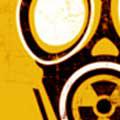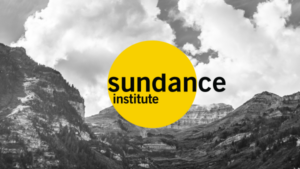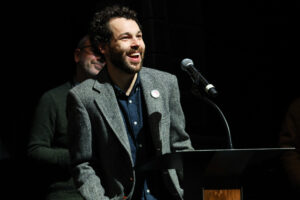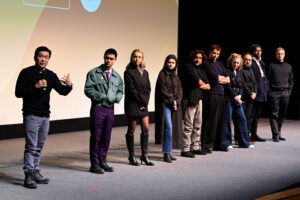Joseph Beyer, Director of Digital Initiatives for Sundance Institute
Lance Weiler doesn’t like to do things half-way. As a self-declared “Story-Architect for Film, TV and Games,” Weiler is considered a thought leader and pioneer in the mashup culture of #transmedia. His early influence and consultations helped shape the very structure of the Sundance New Frontier Lab itself.
At the 2011 Sundance Film Festival in Park City earlier this year, he launched his most ambitious multi-layered narrative yet: Pandemic 1.0 “I honestly did too much in retrospect, but I firmly believe any future #transmedia projects interacting with the Film Festival will benefit from our experiences. They’ll be able to study what we tried and learn important lessons from it. Activating projects like this within large live events has challenges for sure, that’s part of what we learned,” Weiler said from the Sundance Resort in Utah.
Pandemic 1.0 was a transmedia storytelling experience that spanned film, mobile, online, real-world, social gaming and data visualizations into one narrative experience. Over the course of the 10 day Festival the story unfolded in pieces, enabling viewers-slash-players to step into the shoes of the protagonists themselves.
Weiler and his team wanted to accomplish some key objectives with the project: how could they get data visualizations into a system elegantly? How could real-world and online interactions push and flow their narrative? How could mobile devices and applications fuel discovery of physical locations and events? And finally, how could tactile objects become a part of the experience and central storytelling devices? (Weiler admits to a kind of tech-fetish with toys in his work, Pandemic 1.0 would eventually feature some of his crazier toy ideas). “I believe when audiences can touch something, physically connect with an object, well that’s a powerful point of entry into a story,” he added.
The Pandemic 1.0 story experience starts when a mysterious sleep virus begins to affect the adults in a small rural town, and the youth soon find themselves cut off from civilization and fighting for their lives. Will they survive? Can we then survive?
Weiler’s plans for the Pandemic 1.0 presentation began in 2011 when he shot and created the project’s central media component: a 9 minute short film that introduced his characters and set the premise of his story in motion. The film was shown as part of the Short Film Program at the Film Festival, as well as embedded within the Sundance Mobile Apps and featured in the YouTube Screening Room.
So launched a series of #transmedia experiments that would eventually include such elements as geo-caching of physical objects embedded and tracked with NFC (Near Field Communication) codes, QR (Quick-Response) codes, UPC Codes and GPS Mapping as well as a physical “Mission Control” installation at the Film Festival’s New Frontier exhibit space. “Mission Control” aggregated and visualized all the data points being received by the game mechanics and algorithyms Weiler’s team set up to automatically spread, grow and stall the pandemic that gives the project it’s name – all actions that were based on the interplay and actions of the users-slash-players.
The central nervous system of Pandemic 1.0 was it’s cause-and-effect narrative as seen on the website Hope Is Missing. It was designed to mashup and mixup the content and data being generated by users and reconfigure it to unlock geosocial and story clues that would inform how players tried to “survive” the catastrophe.
Twitter was also huge for the project’s success. Over the course of the Film Festival, the project hashtag (#pandemic11) was Tweeted almost 5,000 times, adding more data to the mix and allowing players to follow even more layers of discovery and story. Actors with the project had scripted Twitter feeds that also fed the narrative and shifted and changed based on the game play of the project, conversely the actions of the audience affected how long the characters would live or die within the world of Pandemic. 50 Nexus-S game phones provided by Google challenged users with morality questions that were later extracted and visualized through Microsoft Surfaces in the “Mission Control” installation.
All of this data and all of the connections within the project emphasized a kind of hyper-relationship between the Global and the Local, which was exactly what Weiler and his team wanted and envisioned. In the end there were hundreds of story touch points, dozens of technology platforms used and multiple-layers of narratives and interactions that defined the complex world of Pandemic 1.0 “I think if I had it to do over I’d probably see the opportunity to do more with far less. I think we could have accomplished the same results with probably one-third the project scope. That’s something I’d approach differently,” Weiler shared with the New Frontier Lab audience.
“I would also make our calls to action clearer, more straightforward …” he added. “I would look and study the interactions I was asking of the audience and focus only on those that directly affected the outcome of the project and story. I’d love to hone those calls and strengthen the experience with the story itself. In some ways it’s like rewriting, I did three complete drafts of the project narrative with my writing partner. Rewriting is key, it’s what I learned at the Sundance Screenwriter’s Lab. I think in rewriting, you find more of the story … or a more focused version of it I guess. I’m deeply interested in how the themes are manifested,” Weiler said.
“I also learned I’ll always want more time, more staff to support what we’re doing, better back-up plans in case something doesn’t get discovered or doesn’t roll out the way we expected or wanted, those things apply to every project I’m a part of these days,” Weiler laughed.
With Pandemic 1.0 he may get his chance: plans are in place for a new updated version of the project, Pandemic 2.0, to roll out next year. Weiler’s spirit to experiment and push envelopes with his work only increases with each project or chapter he completes. His latest endeavor is a children’s media literacy collaboration called “Robot Heart Stories” which he launched 7 days ago. It’s a cross cultural artspace designed to connect kid’s ideas for stories with animators who will help bring them to life. They plan to take all the creative work and literally blast it into space next year, so every Kid-Creator can “look up in the sky and ‘see’ their work in the stars. Pretty cool, huh?” Weiler explained.
On the ground at the Film Festival, Weiler’s expenses were broken down into components. His short film cost approximately $3k to complete, his onsite installation and project expenses were approximately $20k and he estimates the partner and technology in-kind donations he received were likely valued at $250k. You can follow Weiler’s work and thoughts on #transmedia on his blog LanceWeiler Dot Com (if you can keep up).







